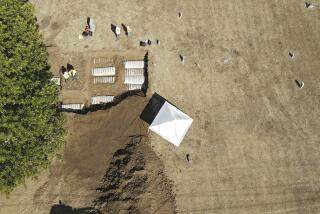City Begins to Acknowledge ’21 Race Riot
- Share via
TULSA, Okla. — At 92, Robert Fairchild is losing his hearing, but he can still make out the distant shouts of angry white men firing guns late into the night 75 years ago. His eyes are not what they used to be, but he has no trouble seeing the dense, gray smoke swallowing his neighbors’ houses as he walked home from a graduation rehearsal, a frightened boy of 17.
His has been a life of middle-class comfort, a good job working for the city, a warm family life. But he has never forgotten his mother’s anguish in 1921 as she fled toward the railroad tracks to escape the mobs and fires that destroyed the vibrant black community of Greenwood.
“There was just nothing left,” says Fairchild today.
It was 75 years ago this month that Tulsa experienced one of the worst race riots in the country’s history. The death toll during the 12-hour rampage is still in dispute, but estimates have put it as high as 250. More than 1,000 businesses and homes were burned to the ground, scores of black families were herded into cattle pens at the fairgrounds, and one of the largest and most prosperous black communities in the United States was turned to ashes.
Until very recently, the events of June 1, 1921, were rarely--if ever--spoken of publicly in white Tulsa. This time it was different. Blacks, whites, Christians and Jews came together at Greenwood’s Mount Zion Baptist Church--torched during the riot and later rebuilt--to acknowledge for the first time this tumultuous moment in Tulsa’s past. Benjamin Hooks, former executive director of the NAACP, spoke at a prayer service, and a tall black granite monument was unveiled, dedicated to the glorious neighborhood once known as “Black Wall Street.”
At a time when acts of hate and racial divisiveness are cropping up across America--from the burning of black churches to housing discrimination--this event is a small but crucial step toward healing taken by a city that is still largely segregated. Strangely enough, the very existence of this blot on Tulsa’s history has been credited with fostering a spirit of tolerance today. Many people believe that because of it, city officials have felt pressured to resolve other potential racial crises expeditiously.
“Tulsa never again wanted to be exposed as a racist community because that would be bad for business, and so many of these milestones became easy,” says B.S. Bishop, a leading black minister here who was involved in the early fight for integration. “All you’d have to do is mention the riot and everyone would cringe. It just wasn’t done.”
Tulsa’s white mayor, Susan Savage, found that out last fall when she addressed a national NAACP conference here, and took the unusual step of citing the riot as a reminder of past intolerance. To her astonishment, state Rep. Don Ross jumped up and embraced her. Ross, who represents Greenwood, told her it was the first time he had ever heard a white politician raise the issue at a public event.
In 1921 in Tulsa, Greenwood was the place to be. By then, Tulsa’s black population was estimated at a robust 11,000, and this 34-square-block area housed two newspapers, 12 grocery stores, two schools, 23 churches, two theaters, a pharmacy, a library, restaurants, four hotels, doctors, lawyers and dentists. Tulsa became, in effect, two cities--one black and one white.
There are some blacks today who believe that it was the jealousy over Greenwood’s economic success that lay behind the riot. The catalyst was an unlucky black teenager named Dick Rowland.
Here’s what is believed to have happened, according to Scott Ellworth’s 1982 history, “Death in the Promised Land,” the definitive book on the subject:
Rowland, 19, a shoeshine boy, boarded an elevator of a downtown building on May 30 to use a restroom designated for blacks. No one will ever know what transpired on that elevator, but it is commonly believed that Rowland tripped and bumped into Sarah Page, a 17-year-old white elevator operator. To keep her from falling, he grabbed her arm, causing her to scream.
It wasn’t until the next morning that Rowland was arrested and charged with assault.
Later that day, before the police had completed their investigation, the now-defunct Tulsa Tribune published an inflammatory article on the front page of its afternoon editions. It stated that Rowland had attacked Page and tore her clothing, and noted that he went by “Diamond Dick,” a moniker never heard by his family and friends. (That article and an accompanying editorial were later torn from archived copies of the newspaper and no known copies exist.)
Just hours after the paper hit the streets on May 31, nearly 2,000 whites began massing outside the jail where Rowland was being held. Rumors of an impending lynching raced through north Tulsa, inciting armed black men to join the courthouse throng. Tempers inevitably flared and before long, mobs of white men were racing across the tracks through Greenwood with burning torches, shooting some blacks and dragging others out of their homes. By midnight, north Tulsa was in flames.
More to Read
Sign up for Essential California
The most important California stories and recommendations in your inbox every morning.
You may occasionally receive promotional content from the Los Angeles Times.













